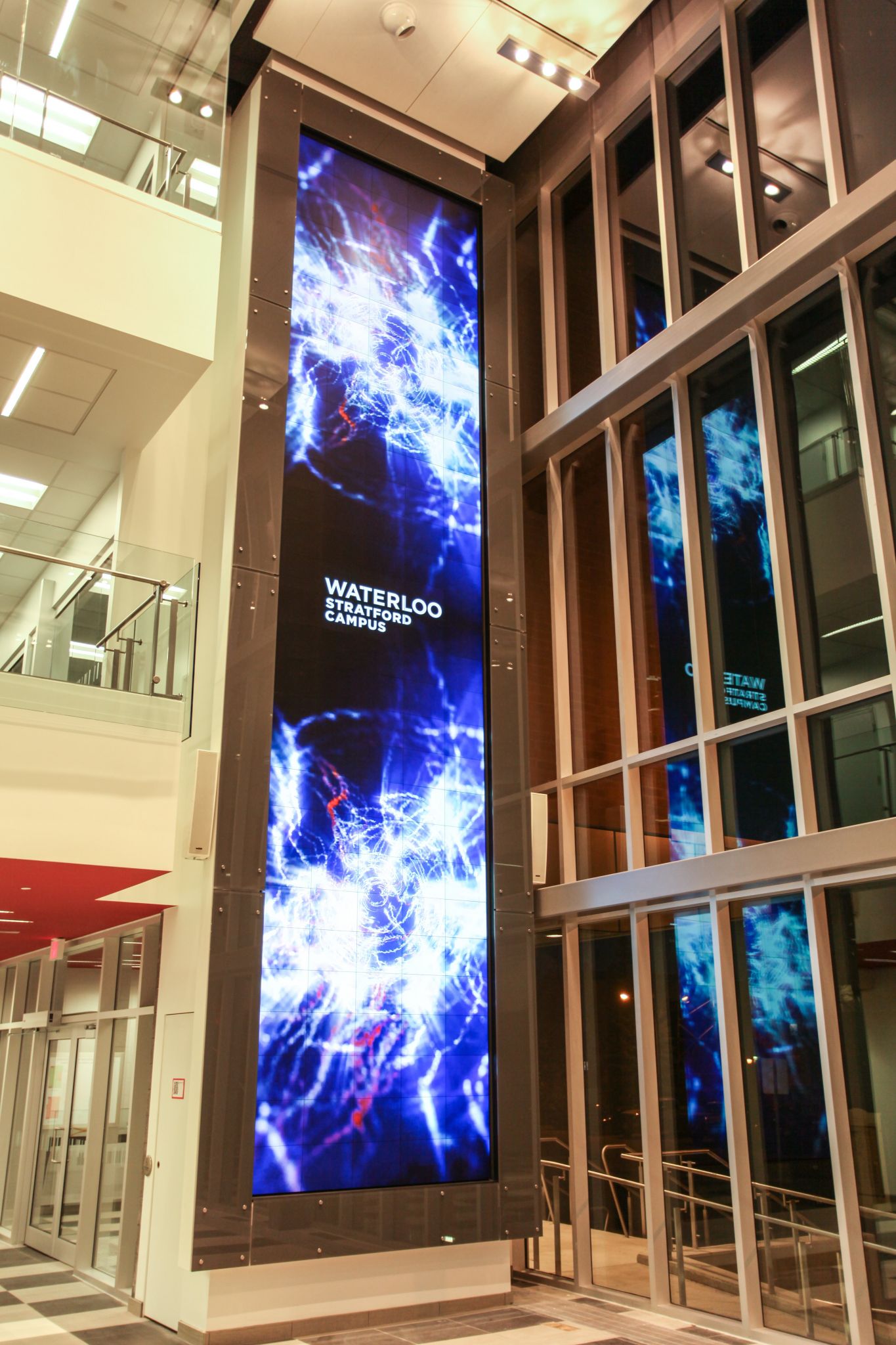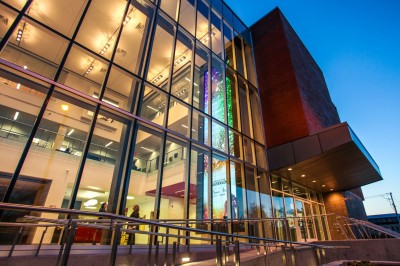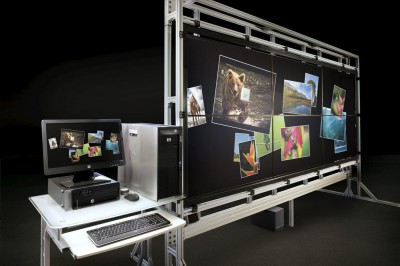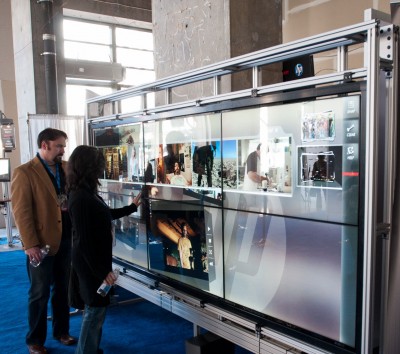Digital Signage: Rise of the video wall
by all | 3 April 2013 8:30 am
 [1]
[1]Photos courtesy Christie and Westbury National Show Systems
By Peter Saunders
On October 16, 2012, the University of Waterloo held the grand opening of its new campus in downtown Stratford, Ont. As home to the university’s digital media program, the campus represents an intersection of technology, arts and business. To visualize this convergence of concepts, the ribbon-cutting ceremony took place in the main campus atrium against the backdrop of a towering 2 x 9-m (6.5 x 30-ft) video wall, comprising 150 MicroTile rear-projection ‘cubes,’ designed and manufactured by Christie Digital Systems Canada in nearby Kitchener, Ont.
In fact, the three-storey structure represented the tallest MicroTiles installation anywhere in the world. Brilliant fireworks were displayed when the wall was illuminated for the first time during the opening celebrations.
To secure the video wall in place, RP Visual Solutions worked with Christie’s research and innovation group to design and produce a rear-mounting bracket with steel support beams. Toronto-based Westbury National Show Systems (WNSS) managed the project and the installation on behalf of the university.
A media management system, video processor and content management software allow students to switch between multiple zones of high-resolution or low-resolution content or portray three-storey tall images with uniform resolution across the entire video wall canvas. Even beginner-level students can use the technology.
“The technology will showcase our students’ work, highlight creativity and provide a unique canvas for complex and detailed digital media research, visualization and commercialization,” explains Ginny Dybenko, the campus’ executive director.
“It was a very magical moment for me to see MicroTiles in a higher-education setting, knowing they will make a difference in advancing students’ and researchers’ knowledge of digital media,” says Dave Muscat, Christie’s senior director of sales, who participated in the opening event alongside students, faculty and dignitaries. “We look forward to working with students to develop new ways of collaborating in content creation and design.”
Beyond the video wall’s looming presence, other digital projection and display technologies are already omnipresent across the campus.
Conceptualized as a faceted display system for control room environments, Christie’s Personal Immersive Environment (PIE) arranges four 1.4-m (55-in.) high-definition (HD) liquid crystal displays (LCDs) in portrait mode to create a roughly 90-degree field of view. This can be used to monitor and program the content featured on the larger video wall, but can also be flipped into landscape mode to suit different users’ needs.
Meanwhile, six ceiling-mounted projectors support widescreen, high-resolution presentations on the walls of individual classrooms. Integrated wirelessly into the main network, they can also display campus-wide notifications as needed.
 [2]
[2]A three-storey video wall at the University of Waterloo’s new campus in Stratford, Ont., marks the tallest installation of Christie MicroTiles anywhere in the world.
“Digital media in the university classroom gives students access to technologies that are rapidly evolving in today’s economy,” says Paul Salvini, Christie’s chief technology officer (CTO). “The shaping of the global digital economy begins where students can practice, develop and innovate firsthand and researchers can generate ideas.”
Global growth
Video walls—whether in the form of LCDs, front- or rear-projection systems, light-emitting diode (LED) arrays or plasma displays—are becoming an ever-more mainstream form of digital signage. Last August, Futuresource Consulting estimated the global market for video walls would grow by 60 per cent over the course of 2012, with the combination of LCDs and front-projection systems making up more than 90 per cent of this market.
“This is a very fast-growth area and they are popping up everywhere,” says Andy Bowden, HP’s senior marketing manager for digital signage and commercial displays. “We’ll continue to see more and more of them throughout the world.”
Bowden cites a variety of reasons for this trend, where innovations in technology have broken down past barriers, allowing easier adoption of video walls.
For one thing, display bezels (i.e. screen edges) are becoming narrower, sometimes less than 6.4 mm (0.25 in.), enabling nearly seamless tiled configurations. Also, the prices for large LCDs are coming down, although those with ultra-narrow bezels can cost two to three times more than ‘normal-bezel’ screens. And the development of LED backlighting—i.e. to replace fluorescent lighting—is allowing LCDs to become thinner, lighter, sleeker, easier to service and more energy-efficient, with arguably greater uniformity of colour.
 [3]
[3]A variety of innovations in technology have broken down past barriers, allowing easier adoption of video walls.
Another reason is the growing market demand for digital signage in configurations where standard, stand-alone LCDs would not have sufficient visual impact.
“Immersive visuals demand attention,” says Bob Rosenberry, HP’s global product manager for digital signage and self-service systems. “A multi-screen layout provides this larger canvas for larger spaces, from lobbies to concourses to stadiums. You can pack in more information for menu boards, flight information screens and command-and-control centres. And you can display life-size images, such as a ‘virtual mannequin’ in a fashion store.”
These are just a few examples of how video walls have also become more versatile, whether they are specified for branding, ambience or other purposes.
Setup considerations
It is important to keep the intended purpose in mind when setting up a video wall in the first place.
“The puzzle is getting easier to put together,” says Rosenberry. “Any high-quality video source will technically work. The questions are: do you have enough resolution? What is the viewing distance? Do you need discrete control of each screen or is your content going to be just one constant feed that expands across the displays?”
For the latter option, he recommends a minimum resolution of 1,920 x 1,080 pixels.
Complex content may combine video, text, data, Flash content and other elements. Native resolution for pixel-to-pixel clarity is beneficial for text-heavy content, allowing it to be read easily. Digital signage software can be used to render content up to the desired size.
Colour calibration is an ongoing concern when ensuring consistency across the panels. Many video walls are operated 24-7. As a system ages, the need for colour calibration will become clearer, though most video walls will last two years before the time comes to change out any of their panels.
 [4]
[4]A multi-screen layout with narrow bezels provides a suitable ‘canvas’ for images and information in large facilities like hotels and airports. Images courtesy HP
According to Rosenberry, there are three main connectivity options when setting up a video wall:
- Daisy-chaining—LCDs with integrated video-in and -out ports are connected in a matrix configuration. This is a low-cost option that works with almost any personal computer (PC) player and reduces the need for additional audiovisual (AV) equipment. A built-in scaler is used to expand content across the LCD array.
- PC players with multi-head graphics cards—This equipment supports native resolution with no need for scaling. PC-based software is used to manage the display matrix. The system can easily be expanded as needed.
- Hardware video-wall processors—This equipment enables multiple inputs for display arrays. As such, it has become a popular option for command-and-control centres.
Interactivity
Another trend is the enhancement of video walls with touch-based interactivity. Here too, there are different technology options to consider.
“We see applications being customized to enable an immersive experience,” says Bowden. “You need to consider the user experience, the construction and the cost.”
 [5]
[5]Many video walls are being enhanced with touch-based interactivity. This can be facilitated through the addition of a special overlay.
The following are some common touch-screen technologies:
- Optical—Cameras or sensors are used at the top and/or sides of the video wall structure to detect where the user touches the screen. This option tends to be less accurate than others and cannot support multi-touch applications unless four or more cameras are installed. The wall may also need a custom frame.
- Infrared—This option usually involves a frame around the video wall. Infrared (IR) sensors can be more accurate than optical sensors, though they should only be used indoors, as ambient light rays could interfere with their ability to detect touches.
- Projected capacitive—This multi-touch-friendly technology is common to today’s smart phones and tablet computers, but becomes much more expensive to implement at a larger size than IR or optical touch screens. It is not economical for LCDs beyond 0.5 m (20 in.).
Bowden recommends starting with non-touch-enabled LCDs and then adding a touch-sensitive overlay, as well as specifying ultra-narrow bezels to minimize interference with the user experience.
Further interactivity becomes possible with gesture recognition technologies. Touch systems may recognize on-screen gestures, but extra hardware is needed to support in-air gestures, including three-dimensional (3-D) camera sensors. With a natural user interface (NUI), video walls can enable augmented reality (AR) applications, among others.
“Content strategies are becoming as immersive as possible, as a video wall provides a very different user experience than a smaller screen,” says Bowden. “It’s a question of how to extend user interactions.”
With files from Christie and HP. For more information, visit www.christiedigital.com[6] and www.hp.ca[7].
- [Image]: http://www.signmedia.ca/wp-content/uploads/2014/02/Christie-MicroTiles-at-Stratford-Campus-1.jpg
- [Image]: http://www.signmedia.ca/wp-content/uploads/2014/02/Christie-MicrotTiles-at-U-of-W-Stratford-Campus-2.jpg
- [Image]: http://www.signmedia.ca/wp-content/uploads/2014/02/HP-video-wall-Vantage-Point_b.jpg
- [Image]: http://www.signmedia.ca/wp-content/uploads/2014/02/HOSPITALITY22.png
- [Image]: http://www.signmedia.ca/wp-content/uploads/2014/02/6809018644_d4e66f9822_o2.jpg
- www.christiedigital.com: http://www.christiedigital.com
- www.hp.ca: http://www.hp.ca
Source URL: https://www.signmedia.ca/rise-of-the-video-wall/